iPhone 6s vs iPhone 6s Plus: Why the Plus Wins
From specs and price to battery life, we compare the iPhone 6s and 6s Plus in multiple categories. Here's why the Plus comes out on top.
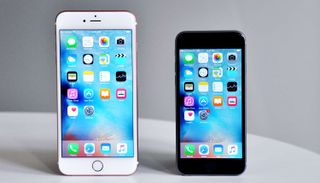
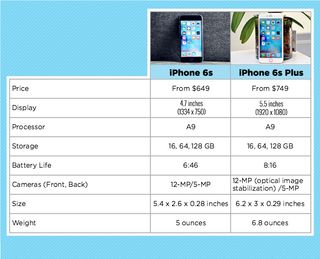
Choosing between Apple's two flagship phones is not just about picking small or big. Yes, the screen sizes of the iPhone 6s (from $649) and 6s Plus (from $749) are a major consideration, but there are other factors at play. Both phones also differ when it comes to their cameras, software, battery life and price.
The new iPhones benefit from the new 3D Touch feature, Live Photos and Apple's fast new A9 processor, but based on our analysis, the iPhone 6s Plus is the better choice. Here's our round-by-round breakdown.
Design/Portability
Both versions of the new iPhone sport sturdier bodies made of 7000 series aluminum, and they have a strong glass cover in the front.

You can also get both devices in the new Rose Gold color, in addition to last year's three hues. Otherwise, the physical difference between these phones is pretty stark.
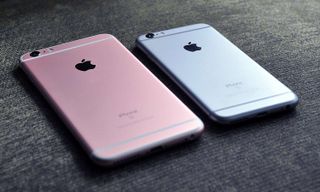
At 6.2 x 3.1 x 0.29 inches and 6.8 ounces, the iPhone 6s Plus is definitely a handful compared with the iPhone 6s' 5.4 x 2.6 x 0.28 inches and 5 ounces.
The Plus fit in my front jeans pocket, but I could definitely tell it was there when I climbed stairs. By comparison, I barely noticed the iPhone 6s in my pocket.
I needed to hold the smaller iPhone 6s closer to my face when watching Game of Thrones.
Winner: iPhone 6s. The iPhone 6s is easier to carry and use with one hand.
Display
This round is a no-brainer. It's not that the iPhone 6s' 4.7-inch screen is bad — it's plenty bright and colorful. However, its low 1334 x 750-pixel resolution seems dated now that you can get a full HD Android phone for hundreds less. The iPhone 6s Plus gives you 1920 x 1080 pixels, plus a bigger canvas at 5.5 inches.
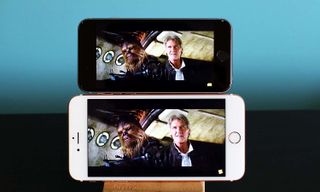
I noticed a huge difference between these two iPhones when watching Game of Thrones on the HBO Go app and various movie trailers. I felt like I needed to hold the 6s closer to my face to see the action.
Although Apple says that both models are equally bright, we did see slight differences in our testing. The iPhone 6s Plus averaged 498 nits, which is brighter than the iPhone 6s (452 nits). Both new iPhones scored nearly perfect color accuracy with Delta-E ratings below 0.5 (0 is perfect).
Winner: iPhone 6s Plus. Its larger and sharper screen is much more impressive.
Camera
The iPhone 6s and 6s Plus make the jump to 5 megapixels from 1.2 megapixels for the front camera and to 12 megapixels from 8 megapixels for the back shooter in this generation.

In daylight photos, the iPhone 6s and 6s Plus delivered similarly impressive results, with fantastic color and contrast.
However, only the iPhone 6s Plus offers optical image stabilization, which enables the handset to capture better images in low light. We put this to the test by using both Apple phones to snap a shot of tchotchkes in low light.

The Plus snapped a brighter photo without losing much sharpness.
Winner: iPhone 6s Plus. You'll simply get better images in dim conditions without having to use the flash.
Software
Both the iPhone 6s and 6s Plus run iOS 9, giving you access to a new Proactive Assistant (swipe left from the home screen), Siri enhancements and improved Notes and Maps apps. However, only the Plus continues to feature a dual-pane mode when you turn the phone to landscape orientation, allowing you to view more info at once.
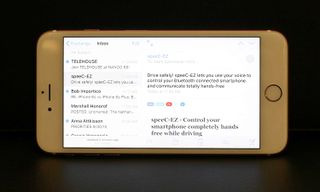
For instance, in the email app, you can see your inbox on the left and the content of your messages on the right.
You should see at least 1.5 hours of more battery life on the iPhone 6s Plus.
Same thing goes for the Notes and Calendar apps. You can also view the home screen in landscape mode — which you can't on the iPhone 6s. In other words, the 6s Plus feels more like a mini computer, and it should for the extra $100.
Winner: iPhone 6s Plus. The dual-pane view in certain apps makes you more productive with the phablet.
Battery Life
With the new Low Power mode option in iOS 9, the new iPhones can last through most of the day, but the iPhone 6s Plus has more staying power. The Plus packs a 2750 mAh battery, versus a 1715 mAh battery for the iPhone 6s.

On our battery test, which involves continuous Web surfing over 4G LTE at 150 nits of screen brightness, the iPhone 6s lasted 6 hours and 46 minutes on AT&T's network. The 6s Plus lasted a much longer 8:43 on T-Mobile. Granted, we've found that T-Mobile phones tend to offer more endurance than other carriers' devices, but you should still see at least 1.5 hours of more runtime on the Plus.
Winner: iPhone 6s Plus. The bigger battery delivers.
Price and Value
If you're willing to pay full retail price, the 16GB iPhone 6s Plus costs $100 more than the 16GB iPhone 6s. For that kind of premium you should get more storage, but that's the subject of another column. The delta looks less daunting, though, when you look at monthly installment plans.

On Verizon, for example, the 16GB iPhone 6s starts at $27.08 per month for 24 months and $31.24 for the 16GB iPhone 6s Plus. That extra $4.16 doesn’t seem like much, but you could apply the same delta toward jumping from 16GB to 64GB on the iPhone 6s. That's four times the storage. AT&T's pricing is fairly similar, with the 16GB 6s costing $21.67 per month for 30 months and $25 for the 64GB model.
Apple charges a little bit more per month because its upgrade program includes Apple Care+ support. Regardless, we're talking about a $4 to $5 monthly difference between the 6s and 6s Plus
Winner: iPhone 6s. Assuming you don't mind a smaller screen, the iPhone 6s is the better deal.
Best Choice: iPhone 6s Plus

Overall, the iPhone 6s Plus is our top pick between Apple's two new handsets. Both are great devices and have a lot to offer, but the Plus' larger and sharper display, better low-light camera and longer battery life make it the one we'd buy.
The iPhone 6s benefits from a lighter and more compact design you can more easily use with one hand (without having to engage Apple's Reachability software) and a lower starting price. Ultimately, though, the iPhone 6s Plus is the best iPhone you can buy.
Sign up to get the BEST of Tom’s Guide direct to your inbox.
Upgrade your life with a daily dose of the biggest tech news, lifestyle hacks and our curated analysis. Be the first to know about cutting-edge gadgets and the hottest deals.
Mark Spoonauer is the global editor in chief of Tom's Guide and has covered technology for over 20 years. In addition to overseeing the direction of Tom's Guide, Mark specializes in covering all things mobile, having reviewed dozens of smartphones and other gadgets. He has spoken at key industry events and appears regularly on TV to discuss the latest trends, including Cheddar, Fox Business and other outlets. Mark was previously editor in chief of Laptop Mag, and his work has appeared in Wired, Popular Science and Inc. Follow him on Twitter at @mspoonauer.


